Poem about Maxim. Retrospective. Part of 6. From Montigny to Hotchkiss
They bought a potion for a crib
On the blood penny.
And the words boiled vividly:
On mitralesea, on grapeshot,
On the horrors of Sedan Sich
Vijitoval deacon.
(“Soldier’s Treasure”, Leonid Trefolev, 1871)
The materials of the “Poem about Maxim” series were mostly liked by VO readers. But many of them expressed a desire to see the story on the pages of the site about the predecessors of Maxim - mitrales or card cases. And yes, indeed, after all, the time when Hiram Maxim constructed his famous machine gun can rightfully be called the era of mitraliasis, which were used both in the field war and navy. True, they were powered by hand! That is, it is obvious that many truly epoch-making inventions usually had its predecessors, and it was just that mitrallise was, in a sense, the ancestor of the machine gun, and almost the closest! After all, people tried to learn how to quickly shoot at the enemy for a very long time, and now, not knowing the machine gun, they came up with it, and for some time she completely replaced it with it. And today, our story will go about mitraliasis - the forerunner of all modern machine guns.
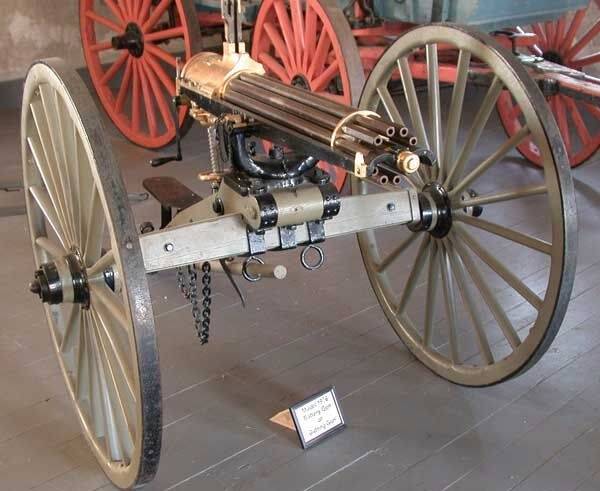
Mitraleza Gatling, Model 1876 of the Year. Fort Laramie, Wyoming, USA.
"Kropilo", "Forty" and "Shotgun"
And so it was that even at the dawn of the use of firearms weapons there were smart people among his supporters, who noticed that it was too long and troublesome to charge him! Well, in fact, does this matter pour gunpowder into the barrel, then insert a wad into it, then a bullet, then once again pour the powder into the pilot hole, inflate the burning fuse, and then apply it to the fuse. And all this time, you are essentially completely defenseless, and you can easily be killed, and many times! Therefore, already at the time of the Hussite wars and the reign of King Henry VIII in England, in the armies of many countries appear the so-called “shooting clubs”, which were short trunks bound together with metal hoops in the number of 5-6 pieces mounted on a wooden handle. It was clamped under the arm, and, turning the trunks with one hand, in turn, with the other they brought a wick to them, which allowed them to shoot at the enemy with a real “burst”. Well, and then, in order not to reload them, with such a “weapon” they went into hand-to-hand combat, the benefit from the blows was simply nothing.
In Henry VIII, such a device was even in his personal use and was called “sprinkle”, with which he used to stroll around London in the dark! But the famous conqueror of Siberia, Yermak Timofeyevich, was armed with a “forty” - a two-wheeled carriage with seven trunks fixed on it at once, also firing by turns. Soon, the fantasy of gunsmiths completely cleared up and 20, 40 and even 60-barreled so-called “organ” guns, which were small-caliber barrels on the frames, whose ignition holes had a common groove for the powder mixture, were used. The powder in it was set on fire, the fire ran along the chute, consistently ignited the fuses, and the trunks that he connected, fired one after the other, and very quickly. But it was already impossible to stop the shooting that started, well, and the “organs” were charged for a very long time, and it was very difficult to take aim from them.
In the Army Museum in Paris there is even an artillery gun with nine channels drilled in one barrel. And the channel that was in the middle, had a larger caliber than the eight side. This "miracle cannon" was used, apparently, as follows: at first they fired from it in the same way as from a conventional gun, and when the enemy was very close, they started firing from all these barrels.
Simultaneously with the “organs”, the so-called “espinol” was also adopted. In this weapon, the barrel was only one, but the charges in it when charging were located one after the other, and they were set on fire from the muzzle of the barrel with the help of a ignition cord. After that, the shots followed one after the other without stopping. However, this “uncontrollable weapon” turned out to be quite dangerous, since it was enough for the powder gases to break through from one charge to the others, as its barrel immediately burst. It was necessary to somehow isolate the charges from each other, and this is how the systems appeared in which the charges and bullets were in a special drum, and set on fire with either a wick or an ordinary flint lock.
One of the inventions in this area was made by English lawyer from London, James Puckl, who patented the “Puckle gun” in 1718. It was a barrel mounted on a tripod with a 11-charging drum cylinder in the breech. Each new shot was made at turn of a drum, as in a revolver. After the ammunition was consumed, the used cylinder was replaced with a new one, which allowed it to produce up to nine rounds per minute. The combat crew consisted of several people, and Pucl assumed to use his “gun” on ships to fire enemy boarding teams.
Gun Puck. Reels are shown for both round and square bullets. Illustration from the patent 1718 of the year.
Interestingly, he developed two versions of his weapon: with spherical lead bullets usual for those years and with cubic bullets that were supposed to cause more injuries and used exclusively against Muslim enemies (including Turks). However, for some reason, Puck’s creation did not make any impression on his contemporaries.
Mitraleza - the word french
Meanwhile, at the beginning of the 19 century, a technical revolution began in Europe, steam driven machines appeared, and the accuracy of the parts produced on them increased dramatically. In addition, unitary cartridges were created, combining gunpowder, primer and bullet into a single ammunition, and all of this together resulted in the emergence of mitralesa or ratchet. The name comes from the French word denoting the canister, although it should be noted that the canisters themselves didn’t shoot at all the canister but bullets, but this was already the case since the first mitraleza in 1851 was invented by the Belgian manufacturer Joseph Montigny, and France accepted it to arm their army.
Mitraleza Montigny. Fig. A. Shepsa.
Enviable ingenuity
I must say that Montigny showed great ingenuity, since the weapons he created were distinguished by very good fighting qualities and an original device. So, 13-mm barrels in it were exactly 37, all of which were charged at the same time with the help of a special plate-holder with holes for cartridges, in which they were held at the edges. The plate together with the cartridges had to be inserted into special grooves behind the barrel, after which, by pressing the lever, they all simultaneously pushed into the barrels, while the shutter itself was locked tightly at the same time. To start shooting, it was necessary to rotate the handle installed on the right side, and here it is through a worm gear and lowered down the plate that covered the strikers, opposite the capsules of the cartridges. The spring-loaded rods at the same time beat on the strikers, and those respectively - on the primers, because of which the shots followed one after the other as the plate went down. It happened like this because its upper edge had a stepped profile, and the rods jumped out of their sockets and beat the strikers in a certain order. At the same time, the not faster the handle rotated, the faster the plate fell and, therefore, faster shots occurred. Experimental calculations could replace the plate with a new one within five seconds, which allowed achieving a rate of fire in 300 shots per minute. But even a more modest value in 150 shots at that time was an excellent indicator.
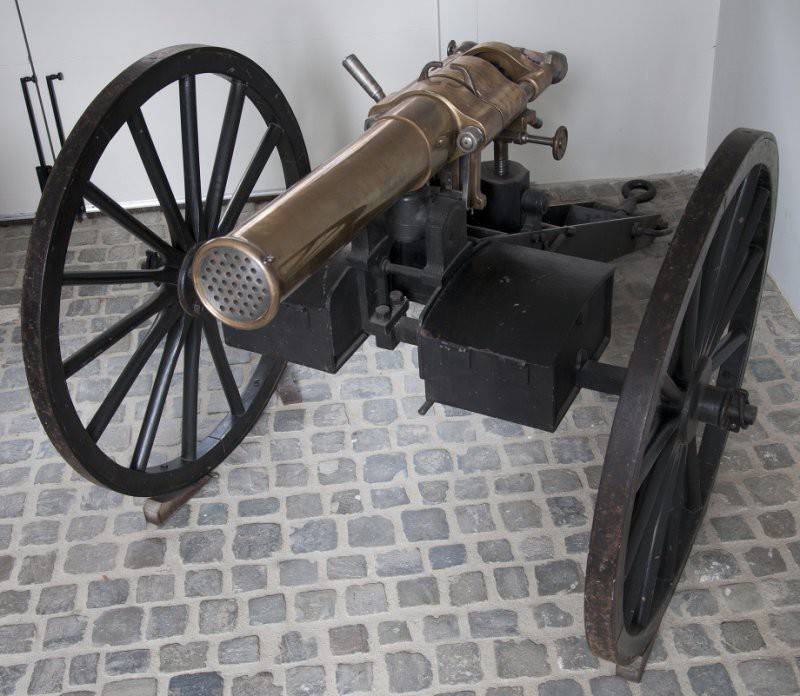
Mitraleza Montigny. (Army Museum, Paris)
In another version of the Versrahl Deffi mitralieza design, the number of trunks was reduced to 25, but its rate of fire has not changed.
Mitraleza Refi.Ris. A.Shepsa
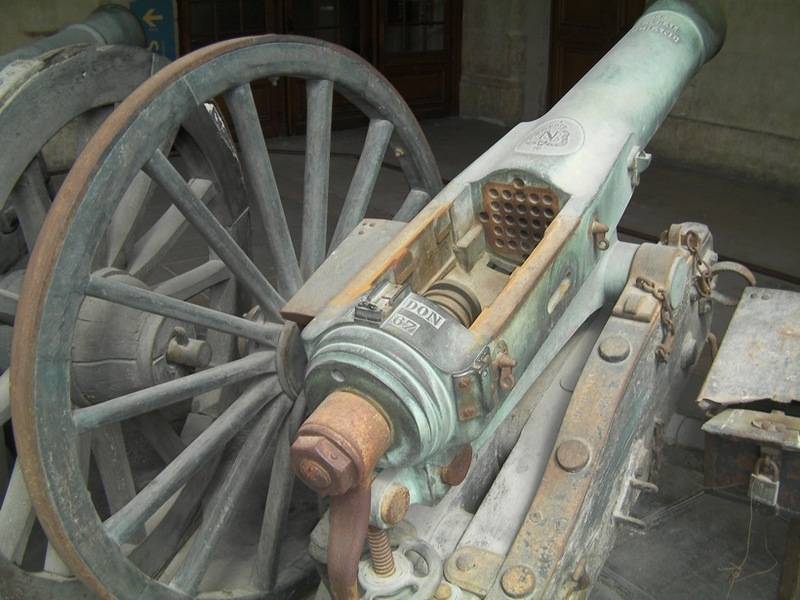
The breech of mitraleza Refi. (Army Museum, Paris)
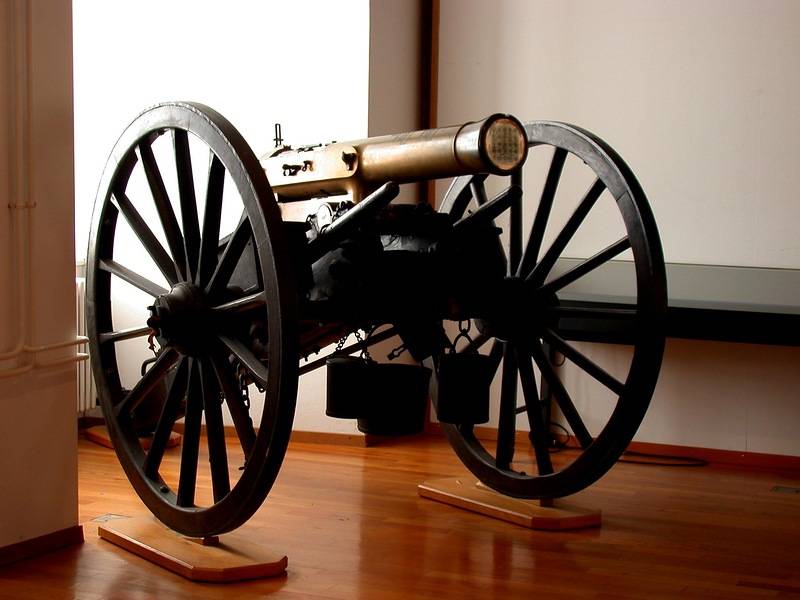
Mitraleza Refffy (Army Museum, Paris)
In mitraliese Refffi, a magazine with cartridges and four guide pins was pressed against the barrel with a screw, which was rotated with a located handle in the breech breech. Between the capsules of the cartridges there was a plate with figured holes, which, by rotating the other handle on the right, moved horizontally. The fighters got into the holes and hit the caps. So shots happened, and after the store was used up, by turning the handle it was released and replaced with a new one.
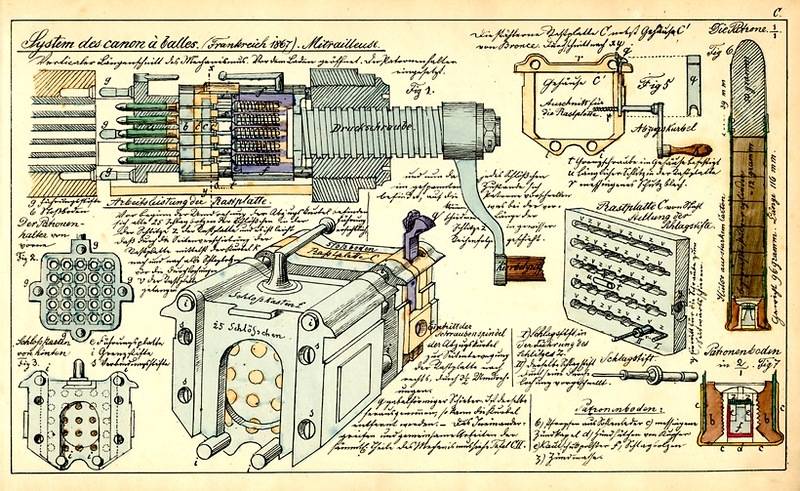
Diagram of the device Mitraleza Refffi and the cartridge to it (right).
Mithrallosis was used by the French during the war with Prussia in 1871, but without much success, since this weapon was new, and they simply did not know how to use it correctly.
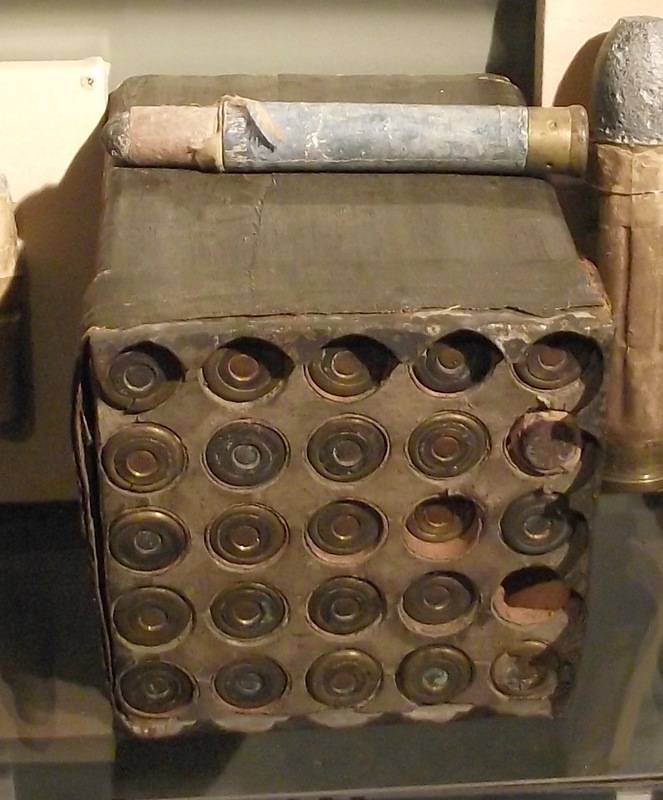
Patron and shop for mitraliese refi.
Mitralese start and lose
And then it was that in 1861, a civil war between North and South started in America and military inventions fell from both sides, as if from a cornucopia. Everyone knows that during the American civil war, in terms of industrial development, northerners were ahead of southerners. Nevertheless, the southerners almost simultaneously with the northerners developed a Williams rapid-fire cannon. And the northerners, in response, created the "Coffee Grinder". So here they went almost flush with each other.
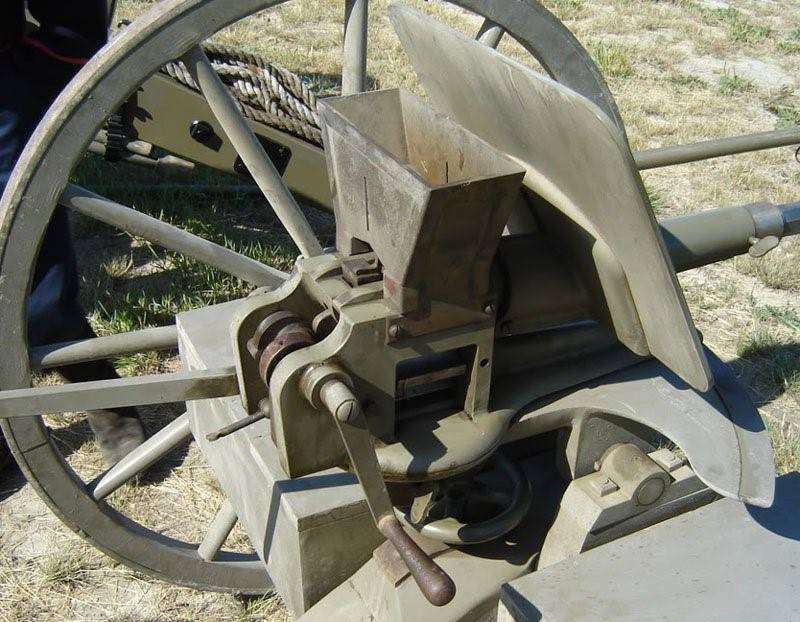
Receiver for “cartridges” and drive handle “Eiger coffee grinder”
Created by Wilson Ager, this mitraleza had a simple but very original design. First of all, she had only one 0,57 inch caliber barrel (i.e., about 15 mm), but she didn’t have a shutter as such! Each cartridge to it at the same time was a chamber and represented nothing more than a steel cylinder in which there was a paper cartridge with a bullet and gunpowder. In this case, the cap was screwed into the bottom of this cylinder or, as they say now, a cartridge. It is clear that these cartridges were reusable, and after firing they could be easily reloaded again. When firing, they were buried in a conical bunker, from which they under their own weight fell into the tray. By rotating the handle, the cartridges alternately simply pressed against the rear section of the barrel, while the drummer cocked and the shot followed. The empty cartridge was removed, and another cartridge was fed in its place, and so the cycle was repeated time after time, right up to the complete emptying of the bunker or stopping the supply.
So it was the Aiger Coffee Grinder that was the first single-barreled tool in the world that could shoot continuously. All previous systems, although firing bursts, were multi-barreled devices.
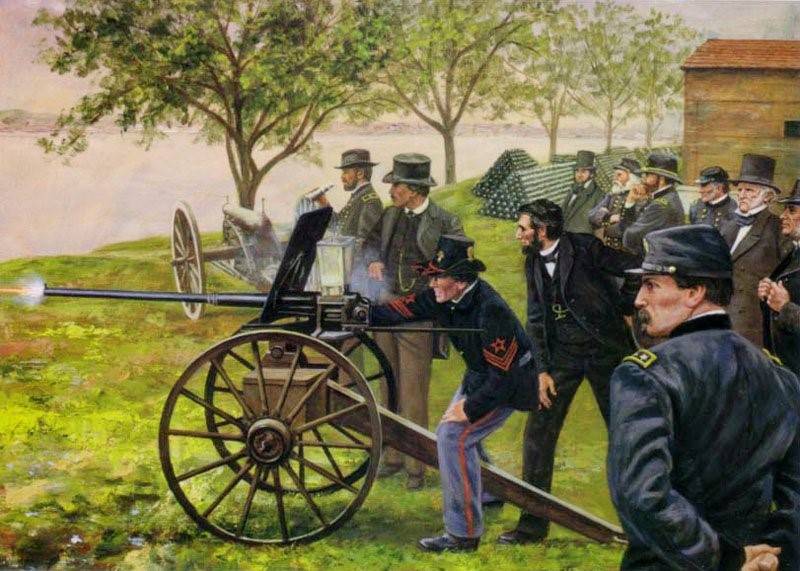
President Lincoln personally participates in the testing of the Aiger gun. Painting by American artist Don Stivers.
According to the legend, US President Abraham Lincoln called the “coffee grinder”, in June 1861, he personally attended her tests, noted the similarity of the gun Aiger with the coffee grinder and so called her. But Ager himself gave his invention very pretentious names - "army in a box" and "army on six square feet."
Abraham Lincoln was very fond of various technical innovations, and could not hold back the delight from what he saw "cars". He immediately offered to adopt it. But the generals did not share his impressions. In their opinion, this gun overheated too quickly when fired, often gave misfires, but most importantly - the price that the inventor demanded for it, and which was 1300 dollars per piece, was clearly overstated.
However, the president still insisted on ordering at least 10 of such canisters, and when they managed to reduce the price to 735 dollars, and also 50.
In early January, the 1862 regiment of volunteers from the state of Pennsylvania and then the 28, 49 and 96 regiment of New York volunteers armed themselves with the first two "Eiger guns" in early January. Already 56 March 29, Middleburg, for the first time in stories wars on the battlefield came the crash of machine gun bursts. Then the soldiers of the 96 of the Pennsylvania Regiment successfully repelled the attack of the cavalry of the Confederates, firing from their "coffee mills". Then the Agrarian mitraliases were successfully used by Northerners under Seven Pines (where Southerners first used Williams guns), in the battles of Yorktown, Harpers Ferry and Warwick, as well as other places, and the Southerners called her the "devil's mill".
However, the spread of this system prevented one fatal flaw. The barrel when firing overheated very much. And it was necessary to remember all the time how to maintain the rate of firing no more than 100-120 shots per minute. But in battle, the soldiers in the heat of battle often forgot about it and the trunks of their guns heated it so that the bullets in them simply melted. Well, and then, after all, it was necessary to keep track of how the end of the cartridge should be thrown into the receiver! So as soon as Mitralese Gatling appeared, these weapons were withdrawn from service.
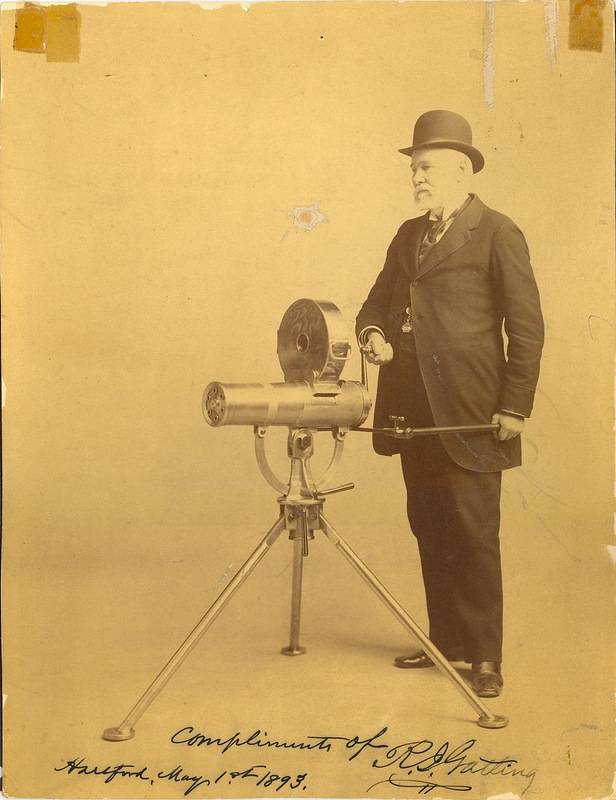
Richard Gatling with his invention.
Then, in 1862, the American Richard Gatling, a physician by profession, designed the rotary trunnion mitraleza, which he called the “battery tool”. The installation had six 14,48-mm trunks rotating around a central axis. Drum shop was on top. Moreover, the designer constantly improved his mitraleza, so that her reliability and rate of fire increased all the time. For example, already in 1876, the five-barreled model of the 0,45 caliber made it possible to fire at a rate of 700 shots per minute, and when firing in short bursts it rose to unimaginable at that time 1000 shots per minute. At the same time, the trunks themselves did not overheat at all - after all, no more than 200 shots per minute accounted for a single barrel, and besides, during rotation, there was a stream of air that cooled them. So we can say that Mitraleza Gatling was the first more or less successful machine gun, despite the fact that it was controlled manually, and not at the expense of any automation!
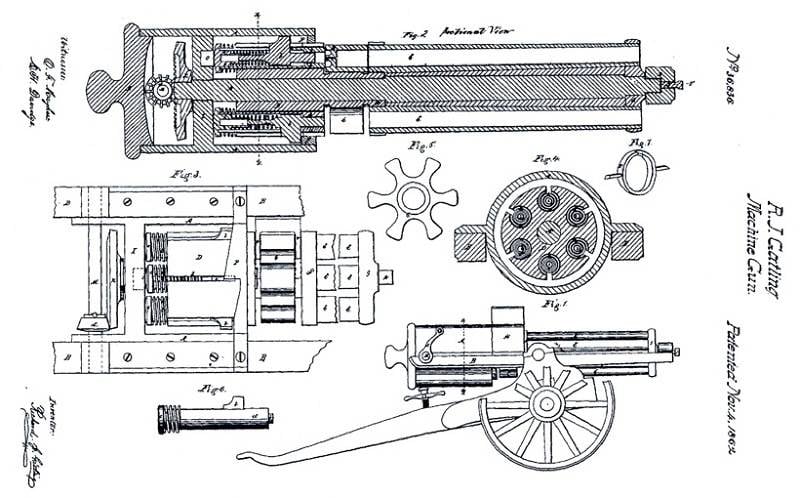
The device Gatling mitralieza patent 1862 year.
As for the Williams' shackle, it had a caliber of 39,88-mm and fired 450-gram bullets. The rate of fire at her was 65 shots per minute. It turned out to be very heavy and cumbersome, so it did not receive wide distribution, but the “Gatlings” eventually spread all over the world and ended up in England and France.
Baranovskiy sucker. Fig. A.Shepsa
They adopted the Gatling system for armament in Russia as well, and in the version with fixed trunks developed by Colonel A. Gorlov and inventor V. Baranovsky, both models had a rate of fire up to 300 shots per minute. They also had the opportunity to "smell gunpowder" in the battles of the Russian-Turkish war 1877-78, and they showed themselves quite well.
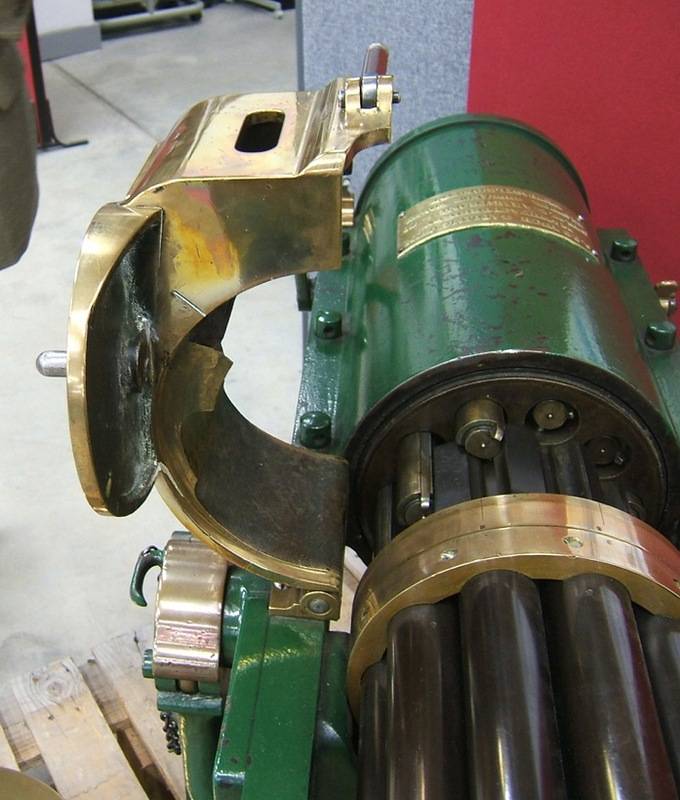
The breech of Mitraleza Gatling. Shutters moving along the sine wave with strikers and extractors are clearly visible.
In the 70 of the 19 century, the Norwegian gunsmith Thornsten Nordenfeld offered his mitrale, which had a simple design, compactness and high rate of fire, and was powered by cartridges from one common horn-type magazine for all its five fixed trunks. The barrels in it were installed horizontally in one row and shot in turns, and its perfection was such that at some stage it made a serious competition to the machine gun of Hiram Maxim that appeared in 1883 year.
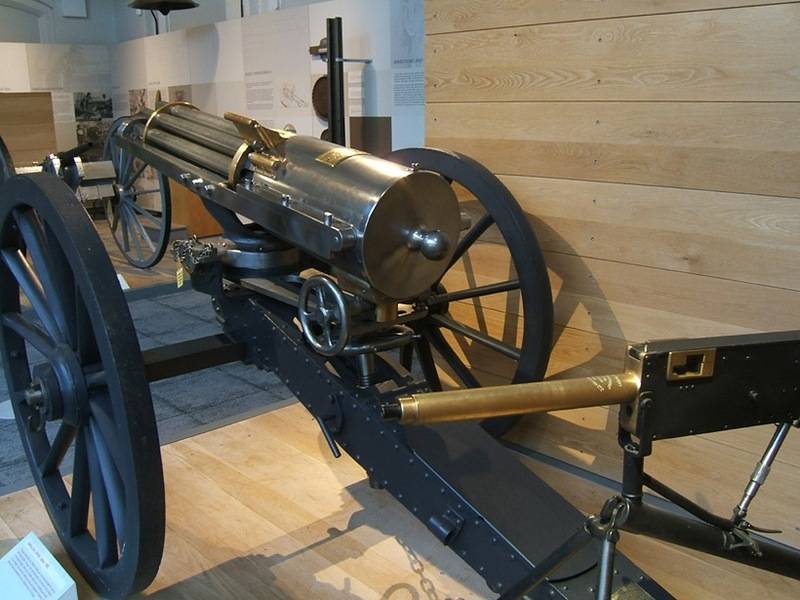
The glittering brass, massive and complex even outwardly of the Mithralea, of course, made a strong impression on the then military, not like the machine gun of Maxim, who had a completely unpresentable look next to her.
Around the same time, the American Benjamin Hotchkiss, a native of Watertown, Connecticut, developed another five-stemmed mitralles of 37-mm caliber, but only with a rotating block of barrels. The first “Hotchkiss” - a multi-barreled gun with swiveling barrels - is often described as a type of “gatling”, although they differed in the device. Hotchkiss himself emigrated to France from the United States, where he created his own production of "revolving guns." His first gun was demonstrated in the 1873 year and proved to be excellent, although it fired slower than its rival, the four-barreled Nordenfeld. This one-inch mitralesez (25,4-mm) could fire 205-gram steel shells and fire up to 216 rounds per minute, whereas 37-mm Hotchkiss “revolver” fired iron grams of 450 grams (1 lb) or even more heavy cast iron shells filled with explosives, no more than 60-ti, but in reality was even less. At the same time, it was arranged in such a way that with each turn of the handle, one shot occurred, and the barrels themselves made five intermittent turns.
Hotchkiss ship cannon. Museum of Artillery in St. Petersburg. (Photo by N. Mikhailov)
That's what's written about her ...
The shell, which fell into the chamber from the store located on top, was fired after every third turn, and the sleeve was ejected between the fourth and fifth. According to the results of the tests, both samples were adopted at once, but since the size of the destroyers grew all the time, Hotchkis eventually bypassed Nordenfeld, and so much so that in 1890, his company suffered bankruptcy! But the five-barrel guns of Hotchkiss, even at the beginning of the 20 century, were still preserved on ships, where they were used to fight the enemy’s high-speed destroyers. But on land, mitraleses lost to machine guns in all respects, although some of them were in service in the armies of different countries, even in the 1895 year!
Socket for installing the store. Museum of Artillery in St. Petersburg. (Photo by N. Mikhailov)
And the shells to her from the Penza Museum of Local Lore ...
The cruiser "Atlanta" was one of the first to receive two mitraleses as a weapon to combat the destroyers.
Subsequently, the idea of a multi-barreled weapon with a rotating block of barrels was embodied in automatic machine guns and cannons in which the barrels are rotated by the force of an electric motor, which allowed them to achieve fantastic results. But this is not history, but modernity, so here we will not talk about it. But it’s really worth telling about mitraliez in literature and in movies.
Mitralese in literature and in movies
Indeed, mitraleses were described in many "novels about the Indians," but such a writer as Jules Verne did not bypass them. In his adventure novel “Mathias Shandorf” - a kind of analogue of the Dumas novel “The Count of Monte-Cristo” on the “Electro” speedboats owned by Mathias Shandorf, there are Gatling mitrallases that help the heroes of the novel disperse Algerian pirates.
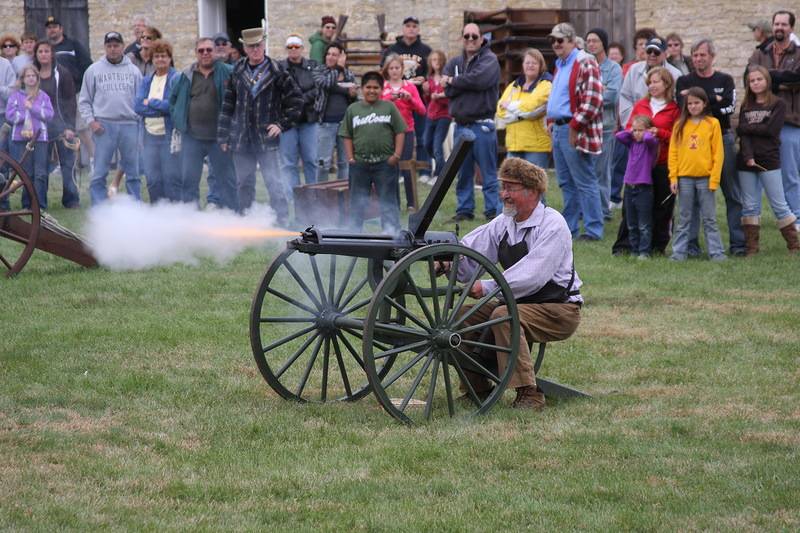
Mitraleza is firing!
Well, thanks to the magical art of cinema, today we can see in action not only samples of the most modern revolving cannons, but also medieval cannon-bodies and later Gatling's “multi-columns”. For example, in the Polish movie “Pan Volodyevsky” (1969), in the scene where the Turks stormed the Polish fortress, the use of these multi-barreled guns is very clearly shown and it is not surprising that the Poles managed to repel the assault with their help!
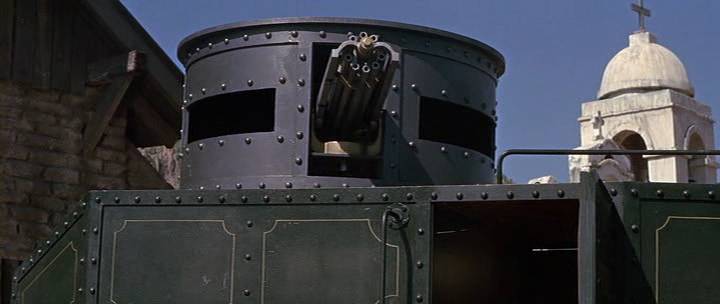
Mitraleza in the movie "Military van"
But in the American movie “Military Van” (1967) with two great actors John Wayne and Kirk Douglas in the main roles, an armored van for the transport of gold equipped with Gatling's mitralleza is represented as a kind of armored tachanka with a prototype of a machine gun inside a rotating tower!
In another movie, which is called “Gatling Machine Gun” (1973), also filmed in the Western genre, this “machine gun” helps to disperse a whole Apache tribe, whose leader, looking at this weapon in action, penetrates with the consciousness that Whites to fight is useless!
In the funny science fiction comedy “Wild, Wild, West” (1999), Gatling’s mitrallises also stand on steam tank, and on a giant walking metal spider - in a word, are used as widely as possible.
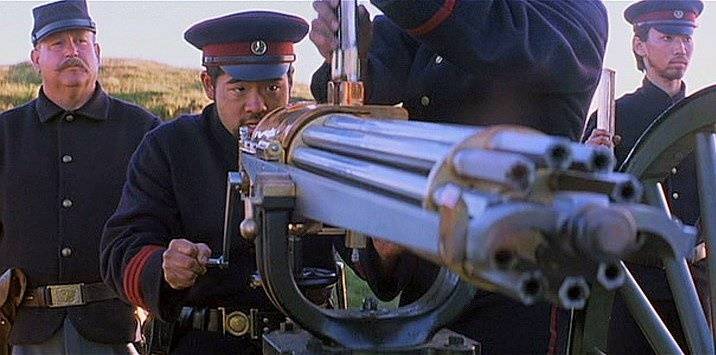
Mitraleza in the movie "The Last Samurai"
Again, with the help of his mitralese in the movie “The Last Samurai” (2003), the attack of the last Japanese samurai-rebels is reflected. Well, modern samples of "gatling" with electric drive can be seen in the James Cameron film "Terminator-2" with Arnold Schwarzenegger in the title role, in which he is using an M214 "Minigun" machine gun with a rotating block of barrels shooting at police vehicles who arrived in alarm to the building Cyberdine companies. In the famous Predator (1987) with the Minigun, Blaine Cooper first walks, and after his death, Sergeant Mack Ferguson, who discharges his entire cartridge case when fired. But Schwarzenegger, in spite of his leading role, for some reason does not touch him in the Predator. By the way, the Minigan machine gun used in the movies “Terminator-2” and “Predator” has never been an individual small arms. In addition, it is “powered” by electricity and needs current up to 400 amperes. Therefore, a copy was made specifically for the shooting, which only fired blank cartridges. The power cable was hidden in the trouser leg of the actor. At the same time, the actor himself was wearing a mask and body armor so that he would not accidentally be hit by the shells flying at high speed, and there was a support behind him so that he would not fall from the strong recoil!
- V.Shpakovsky
- Poem of Maxim (part of 1)
Poem of Maxim (part of 2)
Poem of Maxim (part of 3)
Poem of Maxim (part of 4)
Poem about Maxim. Interlude (part of 5)
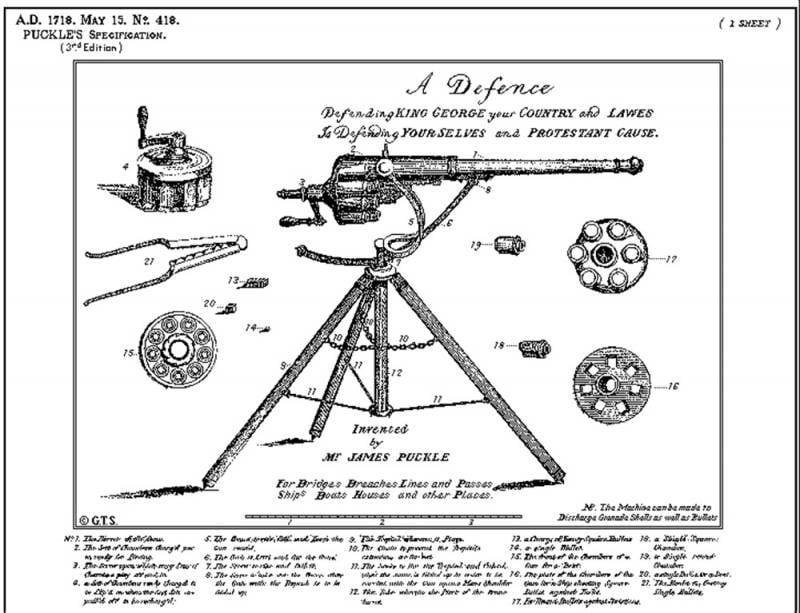
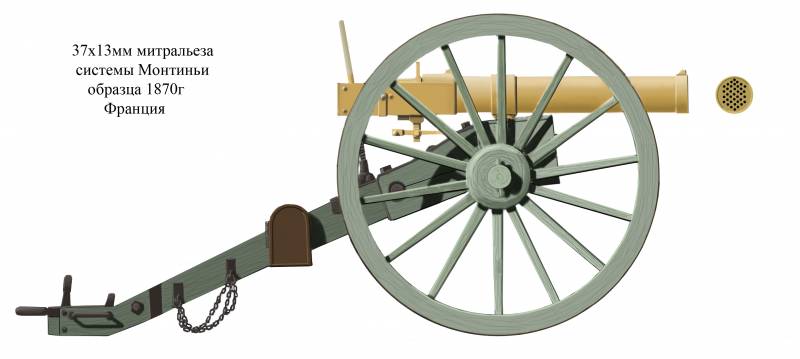
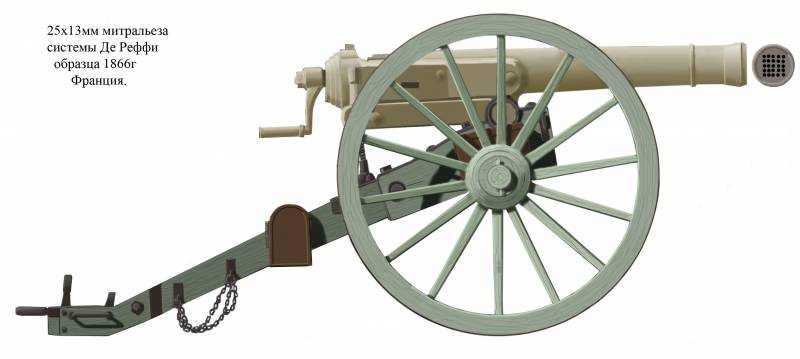
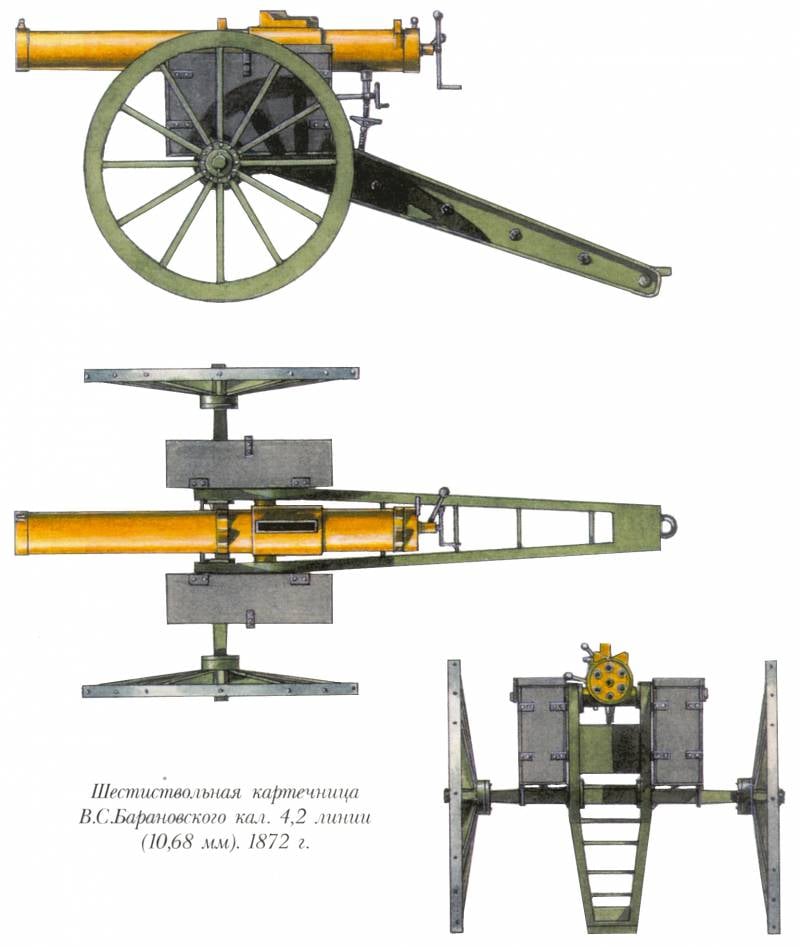
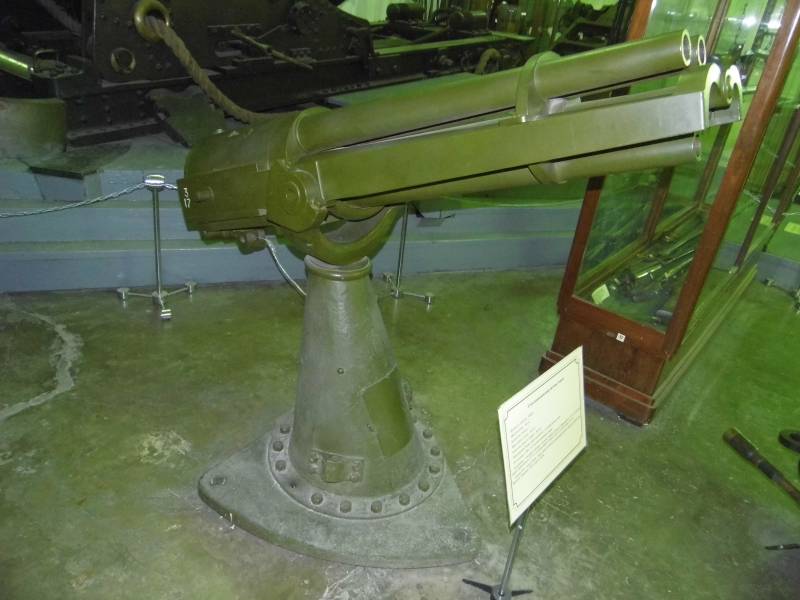
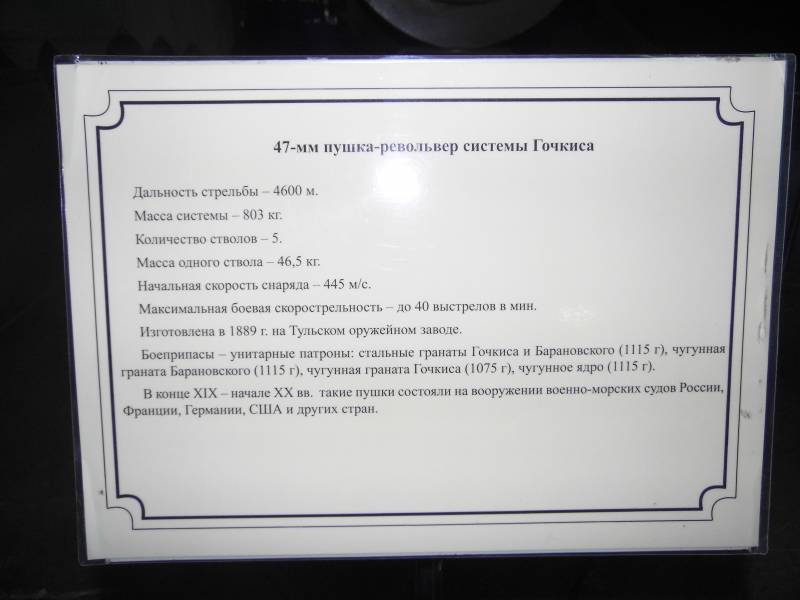
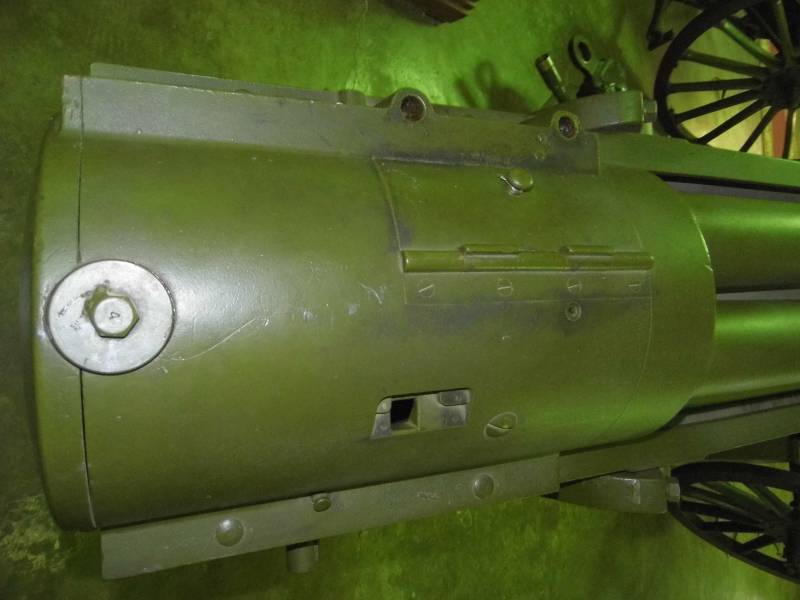
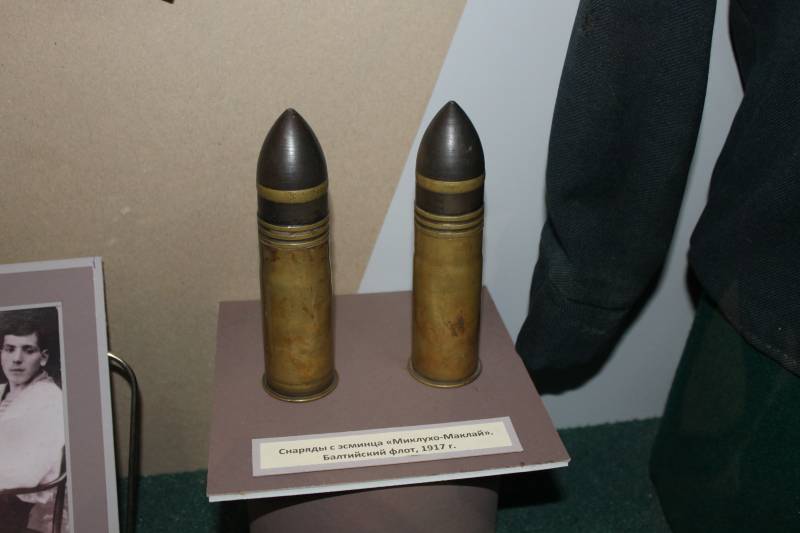
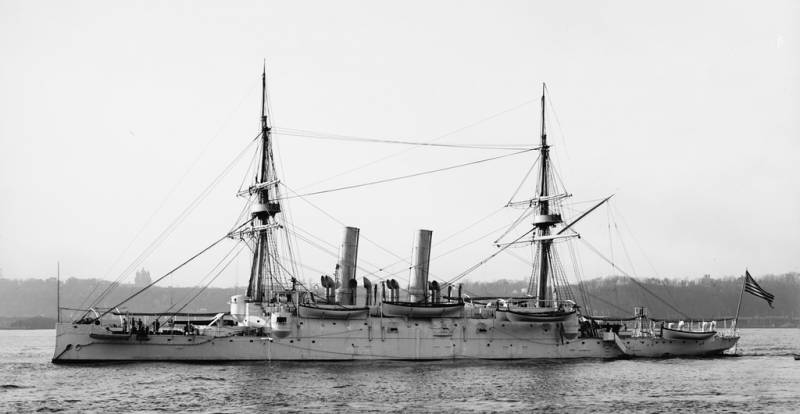
Information